The following report was produced immediately after the 1998 fire. Further discoveries were later made – most notably, a large number of additional medieval cross slabs (see the final paragraph).
Interim Report by Dr Peter F Ryder Feb 1999
Following the tragic fire of 16th September 1998, archaeological work is continuing in the gutted shell of St Brandon’s parish church at Brancepeth, County Durham. An initial interim report on this, produced in mid December 1998, detailed the discoveries of the surviving Anglo-Saxon fabric at the west end of the nave, and of a series of important medieval cross-slab grave covers which have been revealed, mostly re-used as internal lintels to the clerestory windows. This second report deals primarily with the material retrieved as the body of the church was cleared of debris.
The Finds
There were no surprises in the finds retrieved from St Brandon’s Church after the Fire. As could be expected, very little survived the 1200° temperatures which were reached at the height of the blaze. This had the interesting effect of melting the lead from the roof, some of which was transformed into a beautiful yellow glaze (as commonly used on medieval ceramics) which has splashed on, and indeed coated some of the fallen stonework. The Neville monument to the “Peacock of the North”, in the Chancel, now has splashes of this yellow glaze adhering to him. All the very fine carved Woodwork for which the church was famous was destroyed by the fire. The only wood to survive was a few of the huge, solid oak timbers of the roofs, especially that of the Chancel. Samples have been taken from these, with a view to getting them dated by dendrochronology (tree ring dating). The surfaces of the timbers were, understandably, badly charred and we do not know yet whether enough survives to make it possible to date them.
Stonework
The stonework itself has been badly damaged by the fire, with the outer surfaces spalling off. Large segments of the decorated capitals at the top of the aisle pillars fell to the ground. These have been retrieved from the general debris and are now being stored to provide patterns for any future restoration of the stonework. The stone Grave Slabs displayed in the vestry walls have also suffered badly. Thee five cross slabs on the west wall are still in situ but little remains of their original designs. The two on the north wall of the vestry shattered and the various fragments, containing any recognizable workings/lettering, were picked out of the rubble. It has proved possible to reconstruct one of the stones – that commemorating Nicholas Hull of Stockley, who took part in the Rebellion of the North in 1569 and died in October 1600. The Latin inscription says he “sang as a swan sings when it is dying” – a possible reference to his confession? The Marble and Alabaster Monuments around the walls of the church have suffered very badly. Only one in the South Aisle has survived virtually intact, the others have splintered into numerous small fragments. While the pieces have been saved, no attempt has been made, as yet, to reconstruct these monuments. Fragments of the 12th century Font have also been retrieved and it is hoped that it Will prove possible to restore it. The four boxes of bits will pose a challenging 3D jigsaw puzzle for the conservator.
Metalwork
The Brasses in the floors of the South Aisle and the Chancel have survived unharmed and have been removed from the church for safe keeping. The stones in which they were set have not fared so well; the ledger stone in the South Aisle has broken into more than a dozen pieces, but the Knight himself is in quite good condition. The Memorial Plaques from the walls are in various states of repair. Some will simply need cleaning and polishing, others have small globules of lead adhering to them, several are bent and a few are broken, with sections missing. They are all presently being stored. Some, of course, relate to windows (now destroyed) or to past restoration work. By far the most numerous artifacts left by the fire are the hundreds of Handmade Nails. These come in all shapes and sizes, from large ten inch (25cm) nails to small one inch (2.5-3cm) tacks. A sample selection is being kept as part of the archives but many will be made available as souvenirs. Most of the substantial wrought iron Door Hinges are still intact, even though no trace of the doors themselves can be found. Some of these have simple, but attractive decoration. They are being kept towards the restoration of the church. Similarly, a range of seventeenth century “fleur de lis” decorated hinges are the only surviving clues to the existence of the pulpit and other wooden fittings of the church. These, too, are being preserved.
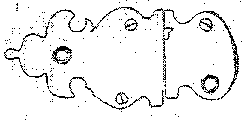
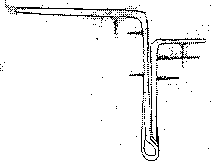
Hinge from 17th Century furnishing (EB98.93)
Glass
“Very little of the window glass remains in situ, as most of the windows were blown out. A few small panes and broken fragments of the 17th century painted glass window in the North Aisle (the oldest window in the church) are being kept. The broken Victorian stained glass is likely to be available as souvenirs in the near future.” Sue Degnan ( Archaeologist/Conservation)
The Building
Once the interior of the church was cleared of debris, the team from Swan Hunters turned their attention to removing the plaster from the walls above the nave arcades and chancel arch, as a preliminary to the walls being thoroughly recorded by means of rectified photography. This revealed that the walls contained masonry of several different periods. The ‘established wisdom’ about the nave walls has been that the original nave was lengthened to the east, and that the point at which the extension took place was marked by the elongate eastern piers of the arcades. Plaster removal showed that there were indeed breaks in the fabric above these piers, but that (at least in the case of the south wall) the older masonry was to the east, not the west of the break. Yet we have just discovered that the west end of the nave appears to be Anglo- Saxon. So how does one ‘read the fabric’ now? It may be that the nave was always as long as it is now, and had early transepts or side-chapels at its eastern end. In the rnid-13th century aisles were added to the west of these. In such cases the arcade arches were often built into the earlier walls (and the walling below only removed when the arches were completed – thus saving on scaffolding). However, here the arches were so tall that little of the old wall would have survived, so the walling above the arches was taken down and rebuilt with them (at least on the south), leaving older walling, with the earlier arches to the transepts, to the east of them. Then, soon after 1300, the transepts were rebuilt, and their arches enlarged to match those further west – but in this case old walling was allowed to survive above them. Later on the whole chancel as rebuilt, then the nave aisles rebuilt wider than before, and ex-tending westwards to flank (‘engage’ is the technical term) the western tower. Later still the Lady Chapel was added to the south side of the chancel, and the sacristy (‘Cosin Room’ added to the north side. Most of these later medieval changes were carried out by the Nevilles, to make the church a fitting mausoleum for their dead. Later still, of course, came Bishop Cosin, who added the North Porch, and (probably) the nave clerestory, as well as providing the sumptuous furnishings, one of his intentions apparently being to make the church his mausoleum (hence the large memorial tablet, never filled 4 on the north of the chancel) – but he became Bishop, so the more prestigious Palace Chapel at Bishop Auckland finally fulfilled that role for him. It is a long and complex story, which we will be able to recount in more detail when the archaeological investigations and recording are complete. Rectified photography is currently underway -although, at the time of writing, archaeological works have been interrupted because of a dangerous deterioration in the condition of the arcades and walls above; it now looks as if these will have to be taken down and re-erected – a sad loss of historic fabric, but scope for further archaeological discoveries.
The Church as it may have developed
What follows is a highly tentative sequence!
The Saxon Church c700-c1000
The Saxon Church, possibly as early as c700 (but could be as late as c1000). Recent observations show that it was plastered externally, so it would have stood out shining white in the landscape.
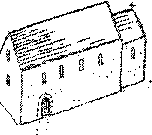
Around 1180 – Late Norman
Around 1180 (Late Norman) the tower is added; the current study of the nave walls suggests that some form of transept of side chapel may have been added by this date.
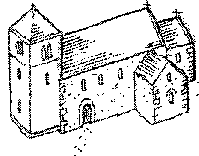
Mid 13th Century (early English)
By the mid-13th century (early English) the tower has been heightened (c. 1200) and an aisle added to the nave; this drawing shows the chancel as rebuilt around this time as well – this is pure guesswork.
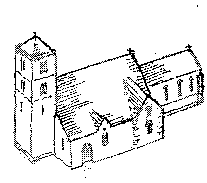
Early 14th Century (Decorated)
The early 14th century (Decorated); the south transept is rebuilt, perhaps as a burial place for the ‘Peacock of the North’ (d.1318).
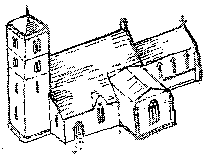
Later 1300s (Perpendicular style)
The Nevilles further enlarge the church; by the later 1300s (Perpendicular style). The chancel and aisles have been rebuilt, and the tower given a new parapet (very like that of one of the turrets at the Castle)
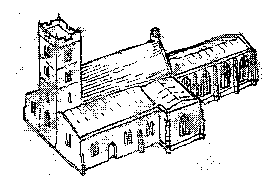
Early 16th Century
In the Early 16th Century the Lady Chapel is added (as another burial chapel for the Nevilles); the Cosin Room (Sacristy) is of about the same date.
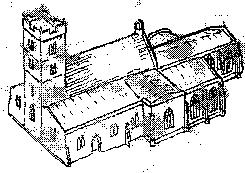
Late 18th Century
By the Late 18th Century the clerestory and two porches have been added (in the 1630s?) and the south aisle has two large Georgian windows and large added buttresses.
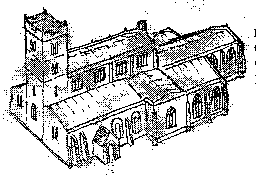
Victorian to pre-fire
The church as it stood before the fire (and should appear when restoration is complete). The Victorians renewed the south aisle windows in the 1860s, and built a new south porch in 1892.
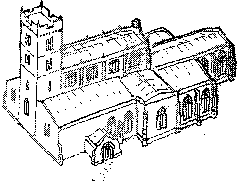
Cross slabs

Another splendid Medieval Cross Slab, a grave cover probably of c 1250; the foliage springing from the cross shaft and flowerlike head depict the Cross as the ‘Tree of Life’ and the pair of shears (possibly a secondary addition) on the left of the shaft indicate the grave of a woman. The slab had been re-used, broken into two, on top of the north wall of the chancel. It has been safely retrieved, and is now stored in the Castle. It is thought that many more similar slabs will come to light if and when fabric has to be rebuilt; Brancepeth could yet end up with the largest collection of cross slabs in the North East.
